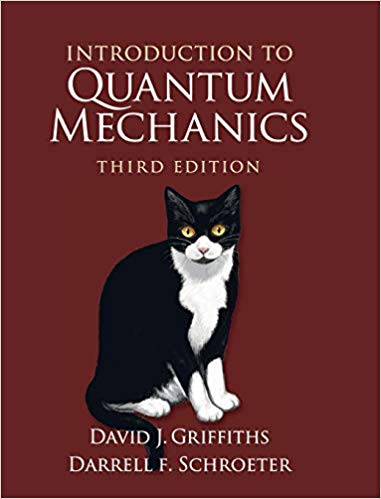 By: David J. Griffiths; Darrell F. Schroeter
By: David J. Griffiths; Darrell F. Schroeter
Edition: 3rd
Year: 2018
Provides clear and accessible explanations of the foundations of quantum mechanics, using an attractive and informal style.
It is thorough, with an appropriate amount of mathematical rigor and a good variety of examples and problems.
Students emerge with a confident understanding of what the theory says and how to apply it, a solid foundation for more advanced work, and an appreciation for one of the greatest products of the human mind.
PART 1: Theory
Chapter 1: The Wave Function
1.1 The Schrödinger Equation
1.2 The Statistical Interpretation
1.3 Probability
1.3.1 Discrete Variables
1.3.2 Continuous Variables
1.4 Normalization
1.5 Momentum
1.6 The Uncertainty Principle
Chapter 2: Time-Independent Schrödinger Equation
2.1 Stationary States
2.2 The Infinite Square Well
2.3 The Harmonic Oscillator
2.3.1 Algebraic Method
2.3.2 Analytic Method
2.4 The Free Particle
2.5 The Delta-Function Potential
2.5.1 Bound States and Scattering States
2.5.2 The Delta-Function Well
2.6 The Finite Square Well
Chapter 3: Formalism
3.1 Hilbert Space
3.2 Observables
3.2.1 Hermitian Operators
3.2.2 Determinate States
3.3 Eigenfunctions of a Hermitian Operator
3.3.1 Discrete Spectra
3.3.2 Continuous Spectra
3.4 Generalized Statistical Interpretation
3.5 The Uncertainty Principle
3.5.1 Proof of the Generalized Uncertainty Principle
3.5.2 The Minimum-Uncertainty Wave Packet
3.5.3 The Energy-Time Uncertainty Principle
3.6 Vectors and Operators
3.6.1 Bases in Hilbert Space
3.6.2 Dirac Notation
3.6.3 Changing Bases in Dirac Notation
Chapter 4: Quantum Mechanics in Three Dimensions
4.1 The Schröger Equation
4.1.1 Spherical Coordinates
4.1.2 The Angular Equation
4.1.3 The Radial Equation
4.2 The Hydrogen Atom
4.2.1 The Radial Wave Function
4.2.2 The Spectrum of Hydrogen
4.3 Angular Momentum
4.3.1 Eigenvalues
4.3.2 Eigenfunctions
4.4 Spin
4.4.1 Spin 1/2
4.4.2 Electron in a Magnetic Field
4.4.3 Addition of Angular Momenta
4.5 Electromagnetic Interactions
4.5.1 Minimal Coupling
4.5.2 The Aharonov–Bohm Effect
Chapter 5: Identical Particles
5.1 Two-Particle Systems
5.1.1 Bosons and Fermions
5.1.2 Exchange Forces
5.1.3 Spin
5.1.4 Generalized Symmetrization Principle
5.2 Atoms
5.2.1 Helium
5.2.2 The Periodic Table
5.3 Solids
5.3.1 The Free Electron Gas
5.3.2 Band Structure
Chapter 6: Symmetries & Conservation Laws
6.1 Introduction
6.1.1 Transformations in Space
6.2 The Translation Operator
6.2.1 How Operators Transform
6.2.2 Translational Symmetry
6.3 Conservation Laws
6.4 Parity
6.4.1 Parity in One Dimension
6.4.2 Parity in Three Dimensions
6.4.3 Parity Selection Rules
6.5 Rotational Symmetry
6.5.1 Rotations About the z Axis
6.5.2 Rotations in Three Dimensions
6.6 Degeneracy
6.7 Rotational Selection Rules
6.7.1 Selection Rules for Scalar Operators
6.7.2 Selection Rules for Vector Operators
6.8 Translations in Time
6.8.1 The Heisenberg Picture
6.8.2 Time-Translation Invariance
PART 2: Applications
Chapter 7: Time-Independent Perturbation Theory
7.1 Nondegenerate Perturbation Theory
7.1.1 General Formulation
7.1.2 First-Order Theory
7.1.3 Second-Order Energies
7.2 Degenerate Perturbation Theory
7.2.1 Two-Fold Degeneracy
7.2.2 “Good” States
7.2.3 Higher-Order Degeneracy
7.3 The Fine Structure of Hydrogen
7.3.1 The Relativistic Correction
7.3.2 Spin-Orbit Coupling
7.4 The Zeeman Effect
7.4.1 Weak-Field Zeeman Effect
7.4.2 Strong-Field Zeeman Effect
7.4.3 Intermediate-Field Zeeman Effect
7.5 Hyperfine Splitting in Hydrogen
Chapter 8: The Varitional Principle
8.1 Theory
8.2 The Ground State of Helium
8.3 The Hydrogen Molecule Ion
8.4 The Hydrogen Molecule
Chapter 9: The WKB Approximation
9.1 The “Classical” Region
9.2 Tunneling
9.3 The Connection Formulas
Chapter 10: Scattering
10.1 Introduction
10.1.1 Classical Scattering Theory
10.1.2 Quantum Scattering Theory
10.2 Partial Wave Analysis
10.2.1 Formalism
10.2.2 Strategy
10.3 Phase Shifts
10.4 The Born Approximation
10.4.1 Integral Form of the Schrödinger Equation
10.4.2 The First Born Approximation
10.4.3 The Born Series
Chapter 11: Quantum Dynamics
11.1 Two-Level Systems
11.1.1 The Perturbed System
11.1.2 Time-Dependent Perturbation Theory
11.1.3 Sinusoidal Perturbations
11.2 Emission and Absorption of Radiation
11.2.1 Electromagnetic Waves
11.2.2 Absorption, Stimulated Emission, and Spontaneous Emission
11.2.3 Incoherent Perturbations
11.3 Spontaneous Emission
11.3.1 Einstein’s A and B Coefficients
11.3.2 The Lifetime of an Excited State
11.3.3 Selection Rules
11.4 Fermi’s Golden Rule
11.5 The Adiabatic Approximation
11.5.1 Adiabatic Processes
11.5.2 The Adiabatic Theorem
Chapter 12: Afterword
12.1 The EPR Paradox
12.2 Bell’s Theorem
12.3 Mixed States and the Density Matrix
12.3.1 Pure States
12.3.2 Mixed States
12.3.3 Subsystems
12.4 The No-Clone Theorem
12.5 Schrödinger’s Cat